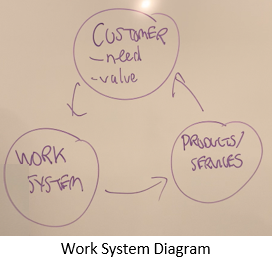The Community Is NOT Your Customer – the counterintuitive way to add more value to your community
This article is also available as a video – click here to watch it – 4 mins with captions.
Many of my clients are in the social sector, and within that, government at all levels. Often in workshops, the question is asked “who is your customer”. The answer…”the community”.
This comes from a good place. But….there is a better way to see who the ‘Customer’ is, which leads to ultimately serving that community better. And…these ideas also apply to those in the private sector too.
Work System Model
Here’s a basic diagram of a work system. These ideas are informed by the work of Ken Miller who wrote a book called “We Don’t Make Widgets”, specifically for government enterprises. Well worth a read.

The idea is that Customers put ‘demand’ onto a Work System. Those ‘Work Systems’ produce ‘Products & Services’ which ideally satisfy that demand. Ken Miller uses the word ‘widget’ to describe products & services, and by seeing a ‘widget’ as anything that the Customer can receive…things get a lot clearer.
For example, this article you a reading right now is a widget, you are the Customer, my ‘Work System’ produced it, and I’m hopefully satisfying your demand for useful info. Other less obvious examples of widgets are phone conversations, a council reserve, a workshop….anything that can be received, used, given, involved in or observed.
So who are the Customers?
Customers then become anyone who receives or uses a Product/Service…a widget. Ken Miller uses the great example of a licence plate. The Customer of the licence plate seems obvious – the driver of the car. But if we use the definition of anyone who uses the widget, another Customer is the police. Which means if we are going to design an effective widget, the demands of the police need to be considered, which will lead to ensuring they are clearly visible at speed.
All Customers have a need they are looking to satisfy (even a drunk & disorderly has a need…the need to be taken off the street!), then within that need there is a certain value they are looking for. Take the example of fast food versus fine dining – the need for both is food…the value of fast food is pace, consistency and price, whereas for fine dining it’s the quality of the food and the experience.

It’s the job of the respective work systems to meet the need at the value required. And by the simple act of coming up with a way to measure that value, you’ve now got a great foundation for getting the team together to continually improve. (You can read or watch more about that here).
What about ‘the Community’ then?
The Community are still very much a part of this show…but now they are in a more useful role which is a Beneficiary. These are people or groups who benefit from the Customer’s needs being met at the value they are looking for.

Think of a local council. If reserves are well-maintained (the widget), as judged by their Customers (those who use or see each reserve) then that’s a factor in the overall community feeling positive.
Other Beneficiaries include employees, and in the case of private organisations…investors. And here’s where a great insight of Ken Miller’s comes in – in government organisations, ‘the community’ are in fact the investors! They might not be voluntary investors – taxes and council rates aren’t optional, but it’s the same structure. One group of investors seeks money, the other seeks community value.
And in both cases this value is provided by meeting Customer needs with the expected value.
The Strategic Question
The choice of which Customers, which needs, and what value is at the heart of strategy. For private organisations, getting this right is shown by profit. For social sector organisations these choices still need to be made because resources are limited. For a council, not all streets can be perfectly maintained. For a school, not all areas of learning can be offered (for example, some schools are known as ‘music schools’, which means they are not something else).
It’s the role of any governing body in the social sector to make the fundamental choice of which groups in the community are we going to make Customers, and which we are not. The goal is always a community where people can flourish…but who we therefore provide Product & Services for is going to be a combination of the people in the community, the conditions they are in and the current and potential capabilities of the organisation itself.
So our fundamental strategic question is therefore:
“Who should our Customers be, what need should we meet and what value should we provide in order to create the benefit to the community we are funded to create?”
Questions like the above need to be considered….but no more often than quarterly. More than that runs the risk of organisational whiplash. And no less than annually.
And current services – no less than monthly do we need to look at some sort of measure of value to check we are doing what we thought we were. (And any more often than weekly is too much)
Get clear on what a Customer is, what they need and what they value….and not only will the community benefit, those working in the organisation will too as they can get a much clearer idea of the difference they are making every day.
